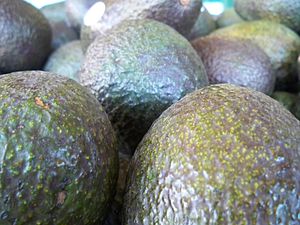
If you are looking for a flavorful way to spruce up your family menu, avocados might be the answer to your prayers. (Photo credit: Wikipedia)
If you are looking for a flavorful way to spruce up your family menu, avocados might be the answer to your prayers. Avocados can liven up almost every one of your family favorites including salads, sandwiches, side dishes, and entrees. Their creamy texture and bright green color make them a favorite of children and adults, and their flavor meshes well with all types of cuisine. Most of us only think of guacamole when we think of them, but there is so much more to the amazing avocado.
Where Do They Come From?
Avocados grow on trees and are native to Central Mexico. Although most people think of them as vegetables, they are actually a fruit and considered to be a berry. Natively grown avocados are called criollo and are smaller than the ones we see in the store. Avocado trees have been cultivated in Central and South America for thousands of years. The word avocado that we use today is believed to come from a mispronunciation of the Aztec word for this small blackish-green fruit, āhuacatl. It is also called an alligator pear, likely because its skin resembles the skin of an alligator.
Do They Offer Health Benefits?
From the Incans to the court of King Charles II, the avocado has long been thought to have aphrodisiac and sexually stimulating properties. While science hasn’t really ruled one way or the other on that claim, the avocado has continued to have a bad reputation even in modern times because around 85% of its calories come from fat. For this reason, it wasn’t until recently that the avocado began to show up on restaurant menus and in make its way onto the plate of average Americans. This is due in part to a broader and better understanding of the differences between good fats that your body needs like the fat found in an avocado and bad fats that are unhealthy like the fat found in a plate of greasy fast food. If you are looking for a great source of healthy fat, you won’t find much that can outshine an avocado.
Additionally, research has shown that the some of the compounds found in avocados have anti-inflammatory properties and can help with conditions like arthritis. Avocados also contain oleic acid, like olives, which help increase the absorption of some nutrients.
How Do You Use Them?
One of the things people find the most daunting about the avocado is getting through the tough skin without compromising the creamy flesh. Here is the best way to peel and seed an avocado.
- Start with a knife that is sharp and at least 2 inches longer than the length of the avocado.
- Cut through to the seed lengthwise all the way around the avocado.
- Cup the avocado in the palm of your hand and twist the two halves in opposite directions until the avocado separates.
- Once the seed is exposed, chop into it about a quarter of an inch with the knife and then use the knife to turn the seed inside the flesh. It will separate and you can easily lift it out.
- From here you can either scoop the flesh out of the skin with a spoon or peel the skin off the flesh with your fingers.
Avocados are great on sandwiches and in salads. You can also find some great recipes that use avocados like Avocado and Tomato Salad on Fill Your Plate.
Related articles
- 4 Tips to Help You Eat Right in the New Year (fillyourplate.org)
- What’s in Season in January (fillyourplate.org)
- 10 Things to Do With Avocados (fillyourplate.org)

